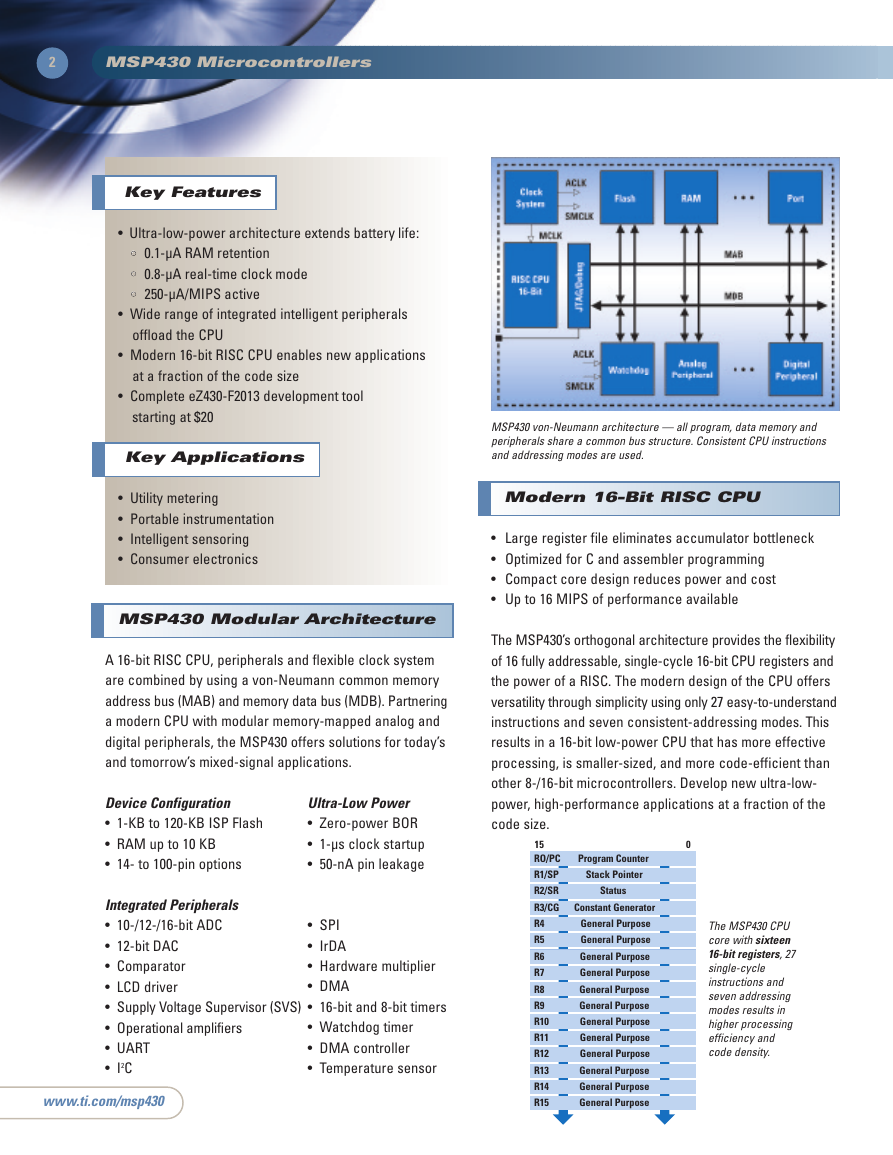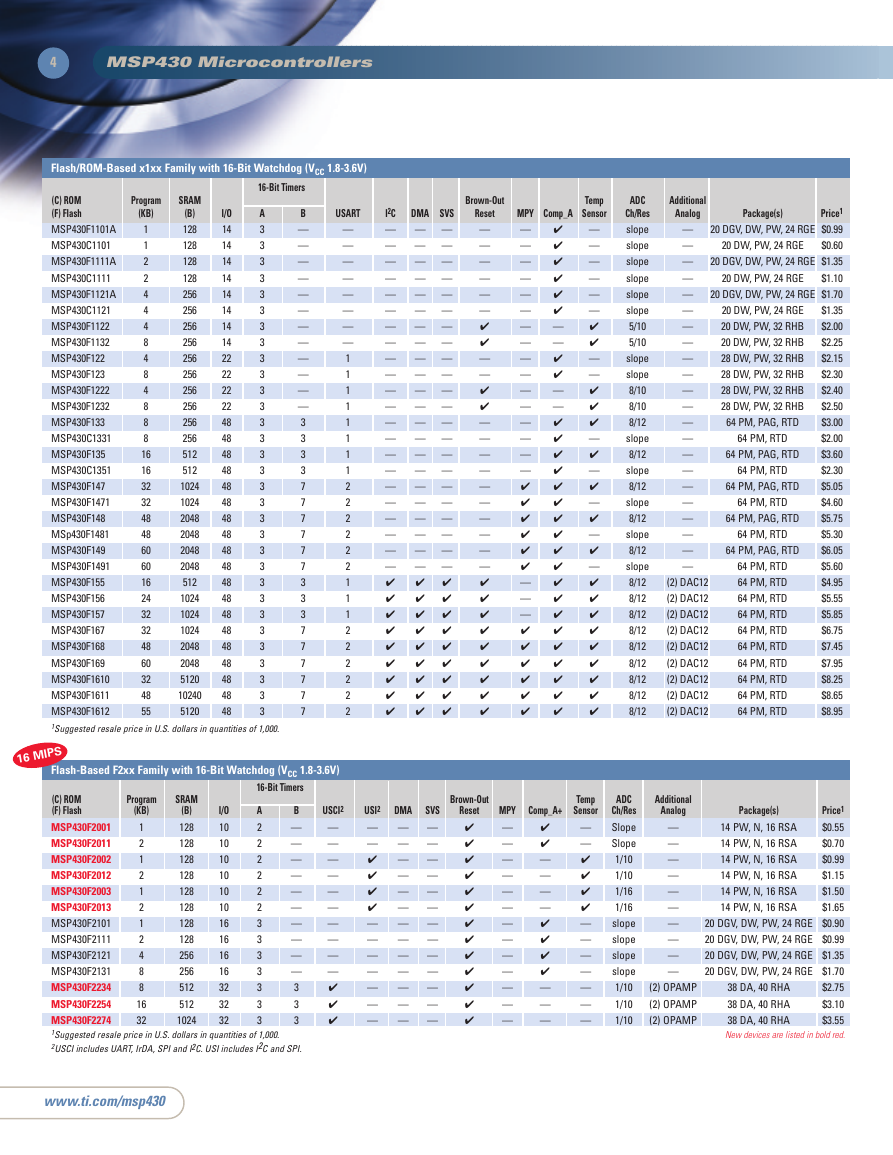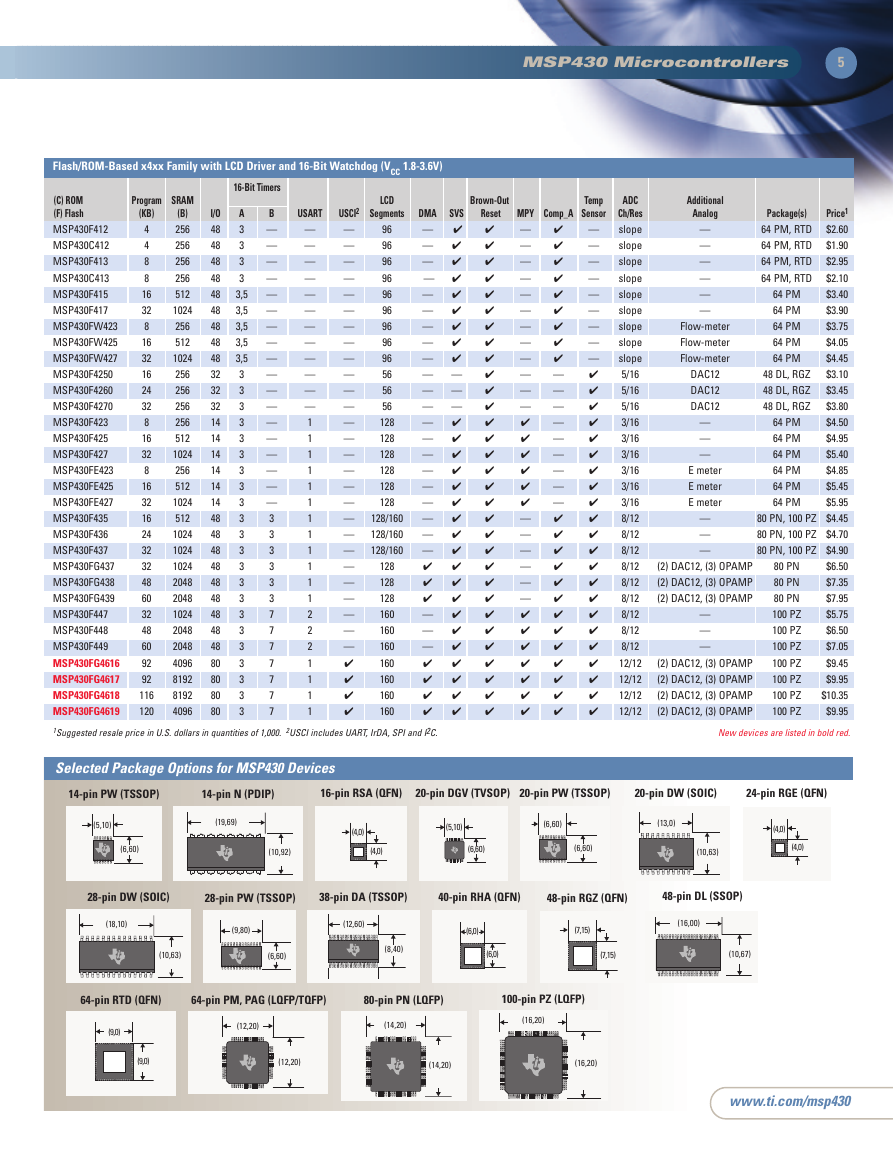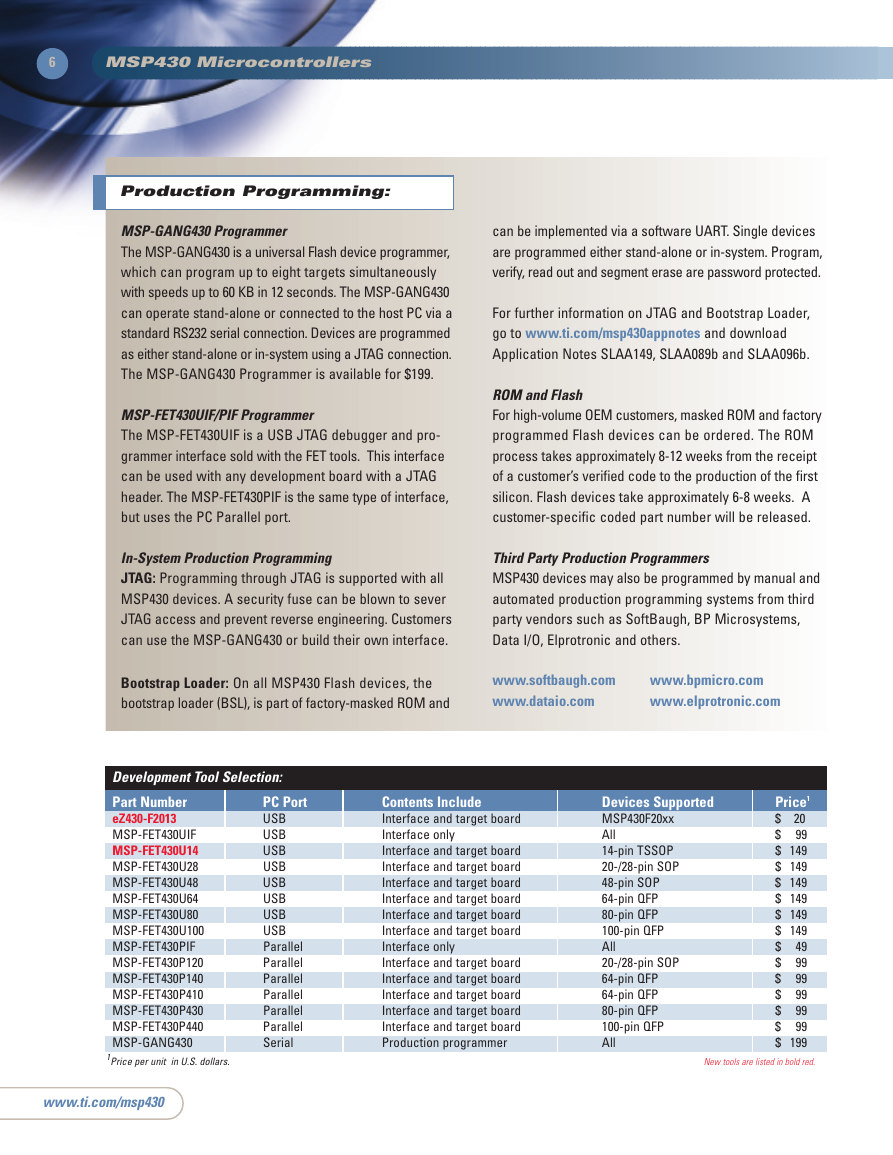微控设计网 http://www.Microcontrol.cn
微控技术论坛 http://bbs.Microcontrol.cn
主题:基于模拟前端信号处理与控制技术的专业论坛,网站.
基于模拟前端信号处理与控制技术的专业论坛、网站.
�
Technology for InnovatorsTM
1H 2006
MSP430 Ultra-Low-Power
Microcontrollers
Embedded Controllers
�
2
MSP430 Microcontrollers
Key Features
• Ultra-low-power architecture extends battery life:
•• 0.1-µA RAM retention
•• 0.8-µA real-time clock mode
•• 250-µA/MIPS active
• Wide range of integrated intelligent peripherals
offload the CPU
• Modern 16-bit RISC CPU enables new applications
at a fraction of the code size
• Complete eZ430-F2013 development tool
starting at $20
Key Applications
• Utility metering
• Portable instrumentation
• Intelligent sensoring
• Consumer electronics
MSP430 Modular Architecture
A 16-bit RISC CPU, peripherals and flexible clock system
are combined by using a von-Neumann common memory
address bus (MAB) and memory data bus (MDB). Partnering
a modern CPU with modular memory-mapped analog and
digital peripherals, the MSP430 offers solutions for today’s
and tomorrow’s mixed-signal applications.
Device Configuration
• 1-KB to 120-KB ISP Flash
• RAM up to 10 KB
• 14- to 100-pin options
Ultra-Low Power
• Zero-power BOR
• 1-µs clock startup
• 50-nA pin leakage
Integrated Peripherals
• 10-/12-/16-bit ADC
• 12-bit DAC
• Comparator
• LCD driver
• Supply Voltage Supervisor (SVS)
• Operational amplifiers
• UART
• I2C
• SPI
• IrDA
• Hardware multiplier
• DMA
• 16-bit and 8-bit timers
• Watchdog timer
• DMA controller
• Temperature sensor
www.ti.com/msp430
MSP430 von-Neumann architecture — all program, data memory and
peripherals share a common bus structure. Consistent CPU instructions
and addressing modes are used.
Modern 16-Bit RISC CPU
• Large register file eliminates accumulator bottleneck
• Optimized for C and assembler programming
• Compact core design reduces power and cost
• Up to 16 MIPS of performance available
MDB
The MSP430’s orthogonal architecture provides the flexibility
of 16 fully addressable, single-cycle 16-bit CPU registers and
the power of a RISC. The modern design of the CPU offers
versatility through simplicity using only 27 easy-to-understand
instructions and seven consistent-addressing modes. This
results in a 16-bit low-power CPU that has more effective
processing, is smaller-sized, and more code-efficient than
other 8-/16-bit microcontrollers. Develop new ultra-low-
power, high-performance applications at a fraction of the
code size.
15
RO/PC
R1/SP
R2/SR
R3/CG
R4
R5
R6
R7
R8
R9
R10
R11
R12
R13
R14
R15
R3/CG
R4
R5
The MSP430 CPU
R6
core with sixteen
16-bit registers, 27
R7
single-cycle
R8
instructions and
R9
seven addressing
modes results in
R10
higher processing
R11
efficiency and
R12
code density.
Constant Generator
General Purpose
General Purpose
General Purpose
General Purpose
General Purpose
General Purpose
General Purpose
General Purpose
General Purpose
General Purpose
General Purpose
General Purpose
15
RO/PC
R1/SP
R2/SR
Program Counter
Stack Pointer
Status
R13
R14
R15
0
Program Counter
Stack Pointer
Status
Constant Generator
General Purpose
General Purpose
General Purpose
General Purpose
General Purpose
General Purpose
General Purpose
General Purpose
General Purpose
General Purpose
General Purpose
General Purpose
16
16-Bit ALU
�
MSP430 Microcontrollers
3
Flexible Clock System
Intelligent Peripherals
• Low-frequency auxiliary clock:
•• Ultra-low-power stand-by mode
• High-speed master clock:
•• High-performance processing
• Stability over time and temperature
The MSP430 clock system is designed specifically for
battery-powered applications. Multiple oscillators are utilized
to support event-driven burst activity. A low frequency
Auxiliary Clock (ACLK) is driven directly from a common 32-kHz
watch crystal or the internal very low-power oscillator—
with no additional external components. The ACLK can be
used for a background real-time clock self wake-up func-
tion. An integrated high-speed Digitally Controlled Oscillator
(DCO) can source the master clock (MCLK) used by the
CPU and sub-main clock (SMCLK) used by the high-speed
peripherals. By design, the DCO is active and stable in 1 µs.
MSP430-based solutions efficiently use 16-bit RISC CPU
high-performance in very short burst intervals. This results in
very high performance and ultra-low power consumption.
Multiple Oscillator Clock System
32.768 Hz
Very Low-Power
Oscillator (VLO)
f
Crystal
Control
Digitally
Controlled
Oscillator
Ultra-Low-Power Activity Profile
ACLK 32 kHz
Low-Power Peripherals
MCLK 100 kHz - 16 MHz
CPU and Peripherals
With purely software-driven functions, the CPU is 100%
active and consuming power. Effectively utilizing peripherals
allows the CPU to be turned off to save power or work on
other activities to achieve the highest performance.
MSP430 peripherals are designed to require the least
amount of software service. For example, the analog-to-digital
converters all have automatic input channel scanning,
hardware start-of-conversion triggers and DMA data-
transfer mechanisms. These hardware features allow the
CPU resources to focus more on differentiated application-
specific features and less on basic data handling. Lower cost
systems can be implemented using less software and
lower power.
MSP430 Product Portfolio
MSP430x1xx
The MSP430x1xx family of MCUs offers a wide range of
capabilities from a simple low power controller with a
comparator, to complete systems on a chip including
high-performance data converters, interfaces and multiplier.
MSP430x4xx
The ultra-low-power MSP430x4xx family has an integrated
LCD controller for low power metering and medical
applications. Several devices offer application-based
peripherals to provide single-chip solutions for flow and
electricity metering.
MSP430F2xx
The new ultra-low-power MSP430F2xx family increases
performance up to 16 MHz. Additional enhancements of
MSP430F2xx, include an integrated ±1% on-chip very low-
power oscillator, software-selectable, internal pull-
up/pull-down resistors and increased number of analog
inputs. The in-system programmable Flash has also been
improved with smaller 64-byte segments and a lower 2.2-V
programming voltage allowing the elimination of external
EEPROMs in most systems.
Ultra-fast 1-µs DCO start-up allows MSP430 systems to remain in
low-power modes for the longest possible interval—extending battery
life. The DCO is fully user programmable.
t
www.ti.com/msp430
�
4
MSP430 Microcontrollers
Flash/ROM-Based x1xx Family with 16-Bit Watchdog (VCC 1.8-3.6V)
16-Bit Timers
Program
(C) ROM
(F) Flash
MSP430F1101A
MSP430C1101
MSP430F1111A
MSP430C1111
MSP430F1121A
MSP430C1121
MSP430F1122
MSP430F1132
MSP430F122
MSP430F123
MSP430F1222
MSP430F1232
MSP430F133
MSP430C1331
MSP430F135
MSP430C1351
MSP430F147
MSP430F1471
MSP430F148
MSp430F1481
MSP430F149
MSP430F1491
MSP430F155
MSP430F156
MSP430F157
MSP430F167
MSP430F168
MSP430F169
MSP430F1610
MSP430F1611
MSP430F1612
1Suggested resale price in U.S. dollars in quantities of 1,000.
SRAM
(B)
128
128
128
128
256
256
256
256
256
256
256
256
256
256
512
512
1024
1024
2048
2048
2048
2048
512
1024
1024
1024
2048
2048
5120
10240
5120
(KB)
1
1
2
2
4
4
4
8
4
8
4
8
8
8
16
16
32
32
48
48
60
60
16
24
32
32
48
60
32
48
55
I/O
14
14
14
14
14
14
14
14
22
22
22
22
48
48
48
48
48
48
48
48
48
48
48
48
48
48
48
48
48
48
48
A
3
3
3
3
3
3
3
3
3
3
3
3
3
3
3
3
3
3
3
3
3
3
3
3
3
3
3
3
3
3
3
B
—
—
—
—
—
—
—
—
—
—
—
—
3
3
3
3
7
7
7
7
7
7
3
3
3
7
7
7
7
7
7
USART
—
—
—
—
—
—
—
—
1
1
1
1
1
1
1
1
2
2
2
2
2
2
1
1
1
2
2
2
2
2
2
I2C
DMA SVS
— — —
— — —
— — —
— — —
— — —
— — —
— — —
— — —
— — —
— — —
— — —
— — —
— — —
— — —
— — —
— — —
— — —
— — —
— — —
— — —
— — —
— — —
�
�
�
�
�
�
�
�
�
� �
� �
� �
� �
� �
� �
� �
� �
� �
Brown-Out
Reset
—
—
—
—
—
—
�
�
—
—
�
�
—
—
—
—
—
—
—
—
—
—
�
�
�
�
�
�
�
�
�
�
�
�
�
�
—
—
—
—
—
—
Temp
MPY Comp_A Sensor
—
—
—
—
—
—
�
— —
— —
—
—
�
— —
— —
—
—
—
—
�
—
—
�
—
�
—
�
�
�
�
�
�
�
�
�
�
�
�
�
�
—
—
—
�
�
�
�
�
�
�
�
�
�
�
�
�
�
�
�
�
�
�
�
�
�
—
�
—
�
—
�
�
�
�
�
�
�
�
�
ADC
Ch/Res
slope
slope
slope
slope
slope
slope
5/10
5/10
slope
slope
8/10
8/10
8/12
slope
8/12
slope
8/12
slope
8/12
slope
8/12
slope
8/12
8/12
8/12
8/12
8/12
8/12
8/12
8/12
8/12
Additional
Analog
Package(s)
64 PM, RTD
64 PM, PAG, RTD
20 DW, PW, 24 RGE
20 DW, PW, 24 RGE
20 DW, PW, 24 RGE
20 DW, PW, 32 RHB
20 DW, PW, 32 RHB
28 DW, PW, 32 RHB
28 DW, PW, 32 RHB
28 DW, PW, 32 RHB
28 DW, PW, 32 RHB
64 PM, PAG, RTD
Price1
— 20 DGV, DW, PW, 24 RGE $0.99
—
$0.60
— 20 DGV, DW, PW, 24 RGE $1.35
—
$1.10
— 20 DGV, DW, PW, 24 RGE $1.70
$1.35
—
$2.00
—
—
$2.25
$2.15
—
$2.30
—
$2.40
—
—
$2.50
$3.00
—
$2.00
—
$3.60
—
$2.30
—
—
$5.05
$4.60
—
$5.75
—
$5.30
—
—
$6.05
$5.60
—
$4.95
$5.55
$5.85
$6.75
$7.45
$7.95
$8.25
$8.65
$8.95
64 PM, RTD
64 PM, RTD
64 PM, RTD
64 PM, RTD
64 PM, RTD
64 PM, RTD
64 PM, RTD
64 PM, RTD
64 PM, RTD
64 PM, RTD
64 PM, PAG, RTD
64 PM, PAG, RTD
64 PM, PAG, RTD
64 PM, RTD
64 PM, RTD
64 PM, RTD
(2) DAC12
(2) DAC12
(2) DAC12
(2) DAC12
(2) DAC12
(2) DAC12
(2) DAC12
(2) DAC12
(2) DAC12
1 6 M I P S
Flash-Based F2xx Family with 16-Bit Watchdog (VCC 1.8-3.6V)
16-Bit Timers
Program
(C) ROM
(F) Flash
MSP430F2001
MSP430F2011
MSP430F2002
MSP430F2012
MSP430F2003
MSP430F2013
MSP430F2101
MSP430F2111
MSP430F2121
MSP430F2131
MSP430F2234
MSP430F2254
MSP430F2274
1Suggested resale price in U.S. dollars in quantities of 1,000.
2USCI includes UART, IrDA, SPI and I2C. USI includes I2C and SPI.
SRAM
(B)
128
128
128
128
128
128
128
128
256
256
512
512
1024
(KB)
1
2
1
2
1
2
1
2
4
8
8
16
32
B
—
—
—
—
—
—
—
—
—
—
3
3
3
I/O
10
10
10
10
10
10
16
16
16
16
32
32
32
A
2
2
2
2
2
2
3
3
3
3
3
3
3
www.ti.com/msp430
USCI2
—
—
—
—
—
—
—
—
—
—
�
�
�
DMA
USI2
SVS
— — —
— — —
� — —
� — —
� — —
� — —
— — —
— — —
— — —
— — —
— — —
— — —
— — —
Brown-Out
Reset
�
�
�
�
�
�
�
�
�
�
�
�
�
MPY
—
—
—
—
—
—
—
—
—
—
—
—
—
Comp_A+
�
�
—
—
—
—
�
�
�
�
—
—
—
Temp
Sensor
�
�
�
ADC
Ch/Res
— Slope
— Slope
1/10
1/10
1/16
1/16
�
— slope
— slope
— slope
— slope
—
1/10
1/10
—
1/10
—
Additional
Analog
—
—
—
—
—
—
—
—
—
—
(2) OPAMP
(2) OPAMP
(2) OPAMP
Package(s)
14 PW, N, 16 RSA
14 PW, N, 16 RSA
14 PW, N, 16 RSA
14 PW, N, 16 RSA
14 PW, N, 16 RSA
14 PW, N, 16 RSA
Price1
$0.55
$0.70
$0.99
$1.15
$1.50
$1.65
20 DGV, DW, PW, 24 RGE $0.90
20 DGV, DW, PW, 24 RGE $0.99
20 DGV, DW, PW, 24 RGE $1.35
20 DGV, DW, PW, 24 RGE $1.70
$2.75
38 DA, 40 RHA
$3.10
38 DA, 40 RHA
38 DA, 40 RHA
$3.55
New devices are listed in bold red.
�
MSP430 Microcontrollers
5
Flash/ROM-Based x4xx Family with LCD Driver and 16-Bit Watchdog (VCC 1.8-3.6V)
�
�
�
�
�
Temp
MPY Comp_A Sensor
—
—
—
—
—
—
—
—
—
—
—
—
�
�
�
�
(C) ROM
(F) Flash
MSP430F412
MSP430C412
MSP430F413
MSP430C413
MSP430F415
MSP430F417
MSP430FW423
MSP430FW425
MSP430FW427
MSP430F4250
MSP430F4260
MSP430F4270
MSP430F423
MSP430F425
MSP430F427
MSP430FE423
MSP430FE425
MSP430FE427
MSP430F435
MSP430F436
MSP430F437
MSP430FG437
MSP430FG438
MSP430FG439
MSP430F447
MSP430F448
MSP430F449
MSP430FG4616
MSP430FG4617
MSP430FG4618
MSP430FG4619
Program SRAM
(B)
256
256
256
256
512
1024
256
512
1024
256
256
256
256
512
1024
256
512
1024
512
1024
1024
1024
2048
2048
1024
2048
2048
4096
8192
8192
4096
(KB)
4
4
8
8
16
32
8
16
32
16
24
32
8
16
32
8
16
32
16
24
32
32
48
60
32
48
60
92
92
116
120
16-Bit Timers
B
A
—
3
—
3
—
3
3
—
3,5 —
3,5 —
3,5 —
3,5 —
3,5 —
—
3
—
3
3
—
—
3
—
3
—
3
—
3
3
—
—
3
3
3
3
3
3
3
3
3
3
3
3
3
7
3
3
7
7
3
7
3
7
3
7
3
3
7
I/O
48
48
48
48
48
48
48
48
48
32
32
32
14
14
14
14
14
14
48
48
48
48
48
48
48
48
48
80
80
80
80
USART
—
—
—
—
—
—
—
—
—
—
—
—
1
1
1
1
1
1
1
1
1
1
1
1
2
2
2
1
1
1
1
LCD
Segments
96
96
96
96
96
96
96
96
96
56
56
56
128
128
128
128
128
128
USCI2
DMA
SVS
— �
—
— �
—
— �
—
— �
—
— �
—
— �
—
— �
—
— �
—
— �
—
— —
—
— —
—
— —
—
— �
—
— �
—
— �
—
— �
—
— �
—
—
— �
— 128/160 — �
— 128/160 — �
— 128/160 — �
—
� �
—
—
—
—
—
� �
— �
— �
— �
�
�
� �
128
128
128
160
160
160
160
160
160
160
�
�
�
�
�
�
�
�
�
�
Brown-Out
Reset
�
�
�
�
�
�
�
�
�
�
�
�
�
�
�
�
�
�
�
�
�
�
�
�
�
�
�
�
�
�
�
�
�
�
�
�
�
—
—
—
—
—
—
�
�
�
�
�
�
�
�
�
�
�
ADC
Ch/Res
— slope
— slope
— slope
— slope
— slope
— slope
— slope
— slope
— slope
5/16
5/16
5/16
3/16
3/16
3/16
3/16
3/16
3/16
8/12
8/12
8/12
8/12
8/12
8/12
8/12
8/12
8/12
12/12
12/12
12/12
12/12
�
�
�
�
�
�
�
�
�
�
�
�
�
�
�
�
�
Additional
Analog
—
—
—
—
—
—
Flow-meter
Flow-meter
Flow-meter
DAC12
DAC12
DAC12
—
—
—
E meter
E meter
E meter
—
—
—
(2) DAC12, (3) OPAMP
(2) DAC12, (3) OPAMP
(2) DAC12, (3) OPAMP
—
—
—
(2) DAC12, (3) OPAMP
(2) DAC12, (3) OPAMP
(2) DAC12, (3) OPAMP
(2) DAC12, (3) OPAMP
64 PM
64 PM
64 PM
64 PM
64 PM
48 DL, RGZ
48 DL, RGZ
48 DL, RGZ
Package(s)
64 PM, RTD
64 PM, RTD
64 PM, RTD
64 PM, RTD
Price1
$2.60
$1.90
$2.95
$2.10
$3.40
$3.90
$3.75
$4.05
$4.45
$3.10
$3.45
$3.80
$4.50
$4.95
$5.40
$4.85
$5.45
$5.95
80 PN, 100 PZ $4.45
80 PN, 100 PZ $4.70
80 PN, 100 PZ $4.90
$6.50
$7.35
$7.95
$5.75
$6.50
$7.05
$9.45
$9.95
$10.35
$9.95
80 PN
80 PN
80 PN
100 PZ
100 PZ
100 PZ
100 PZ
100 PZ
100 PZ
100 PZ
64 PM
64 PM
64 PM
64 PM
64 PM
64 PM
�
—
—
—
—
—
—
—
—
—
�
�
�
�
�
�
�
�
�
�
�
�
�
1Suggested resale price in U.S. dollars in quantities of 1,000. 2USCI includes UART, IrDA, SPI and I2C.
New devices are listed in bold red.
Selected Package Options for MSP430 Devices
14-pin PW (TSSOP)
14-pin TSSOP (PW)
(5,10)
(6,60)
14-pin N (DIP)
14-pin N (PDIP)
16-pin RSA (QFN)
(19,69)
(2,25 Max sq.)
(4,0)
(10,92)
(4,0)
20-pin DGV (TVSOP)
20-pin DVG
(TVSOP)
20-pin PW (TSSOP)
20-pin TSSOP (PW)
(5,10)
(6,60)
(6,60)
(4,15)
(4,15)
(6,60)
20-pin SOIC (DW)
20-pin DW (SOIC)
24-pin RGE (QFN)
(13,0)
(2,25 Max sq.)
(4,0)
(4,0)
(10,63)
28-pin SOIC (DW)
28-pin DW (SOIC)
(18,10)
28-pin PW (TSSOP)
28-pin TSSOP (PW)
(9,80)
(10,63)
(6,60)
38-pin DA (TSSOP)
40-pin RHA (QFN)
48-pin RGZ (QFN)
48-pin DL (SSOP)
(12,60)
(8,40)
(6,0)
(6,0)
(7,15)
(7,15)
(16,00)
(10,67)
64-pin RTD (QFN)
64-pin PM, PAG (LQFP/TQFP)
64-pin TQFP (PM)
80-pin PN (LQFP)
80-pin PN (LQFP)
100-pin LQFP (PZ)
100-pin PZ (LQFP)
(9,0)
(9,0)
(12,20)
(14,20)
(16,20)
(12,20)
(14,20)
(16,20)
www.ti.com/msp430
�
6
MSP430 Microcontrollers
Production Programming:
MSP-GANG430 Programmer
The MSP-GANG430 is a universal Flash device programmer,
which can program up to eight targets simultaneously
with speeds up to 60 KB in 12 seconds. The MSP-GANG430
can operate stand-alone or connected to the host PC via a
standard RS232 serial connection. Devices are programmed
as either stand-alone or in-system using a JTAG connection.
The MSP-GANG430 Programmer is available for $199.
MSP-FET430UIF/PIF Programmer
The MSP-FET430UIF is a USB JTAG debugger and pro-
grammer interface sold with the FET tools. This interface
can be used with any development board with a JTAG
header. The MSP-FET430PIF is the same type of interface,
but uses the PC Parallel port.
can be implemented via a software UART. Single devices
are programmed either stand-alone or in-system. Program,
verify, read out and segment erase are password protected.
For further information on JTAG and Bootstrap Loader,
go to www.ti.com/msp430appnotes and download
Application Notes SLAA149, SLAA089b and SLAA096b.
ROM and Flash
For high-volume OEM customers, masked ROM and factory
programmed Flash devices can be ordered. The ROM
process takes approximately 8-12 weeks from the receipt
of a customer’s verified code to the production of the first
silicon. Flash devices take approximately 6-8 weeks. A
customer-specific coded part number will be released.
In-System Production Programming
JTAG: Programming through JTAG is supported with all
MSP430 devices. A security fuse can be blown to sever
JTAG access and prevent reverse engineering. Customers
can use the MSP-GANG430 or build their own interface.
Third Party Production Programmers
MSP430 devices may also be programmed by manual and
automated production programming systems from third
party vendors such as SoftBaugh, BP Microsystems,
Data I/O, Elprotronic and others.
Bootstrap Loader: On all MSP430 Flash devices, the
bootstrap loader (BSL), is part of factory-masked ROM and
www.softbaugh.com
www.dataio.com
www.bpmicro.com
www.elprotronic.com
Development Tool Selection:
Part Number
eZ430-F2013
MSP-FET430UIF
MSP-FET430U14
MSP-FET430U28
MSP-FET430U48
MSP-FET430U64
MSP-FET430U80
MSP-FET430U100
MSP-FET430PIF
MSP-FET430P120
MSP-FET430P140
MSP-FET430P410
MSP-FET430P430
MSP-FET430P440
MSP-GANG430
1Price per unit in U.S. dollars.
PC Port
USB
USB
USB
USB
USB
USB
USB
USB
Parallel
Parallel
Parallel
Parallel
Parallel
Parallel
Serial
www.ti.com/msp430
Contents Include
Interface and target board
Interface only
Interface and target board
Interface and target board
Interface and target board
Interface and target board
Interface and target board
Interface and target board
Interface only
Interface and target board
Interface and target board
Interface and target board
Interface and target board
Interface and target board
Production programmer
Devices Supported
MSP430F20xx
All
14-pin TSSOP
20-/28-pin SOP
48-pin SOP
64-pin QFP
80-pin QFP
100-pin QFP
All
20-/28-pin SOP
64-pin QFP
64-pin QFP
80-pin QFP
100-pin QFP
All
Price1
$ 20
99
$
$ 149
$ 149
$ 149
$ 149
$ 149
$ 149
49
$
99
$
99
$
$
99
99
$
$
99
$ 199
New tools are listed in bold red.
�
MSP430 Microcontrollers
7
MSP-FET430 Flash
Emulation Tool
Embedded Emulation with
the MSP430
• JTAG based real-time in-system emulation
• Target board, interface box, cable and samples
• CD-ROM includes IAR Kickstart
• USB and parallel cable versions available
The Flash Emulation Tool (FET) supports complete in-system
development and is available for all Flash devices.
Programming, assembler/C-source level debug, single
stepping, multiple hardware breakpoints, full-speed operation
and peripheral access are all fully supported in-system
using JTAG. The FET comes complete with everything
required to complete an entire project.
MSP430 eZ430-F2013
Development Tool
NEW
Rev up your application in minutes with the new eZ430-F2013
complete development tool for only $20! The platform provides
all needed hardware and software in a portable USB stick
enclosure. The eZ430-F2013 uses the included IAR IDE,
providing full emulation with the option of designing a stand
alone system or detaching the removable MSP430F2013
target board to integrate into an existing design. The
MSP430F20xx family, although one of the smallest MCUs
available, does not sacrifice functionality or speed. The
devices combine 16 MIPS and less than 1 microamp standby
with the choice of performance analog converters and are
code-compatible with all existing MSP430 families.
Start today!
For more information visit www.ti.com/ez430
• Development is in-system and subject to the exact same
characteristics of the final application
• Non-obtrusive in portable and high-pin count situations
• Common user software and physical interface
Today’s applications operating at lower voltages, with tighter
packaging and higher-precision analog, benefit greatly
from the MSP430’s in-system emulation approach. The
MSP430’s dedicated embedded emulation logic resides on
the actual device itself and is accessed via JTAG using no
additional system resources. From the first day of development,
firmware engineers can now unobtrusively develop and
debug their embedded code with full-speed execution,
breakpoints, and single steps in an application.
Embedded emulation becomes even more important with
high-performance mixed-signal systems that must maintain
the integrity of microvolt analog signals. Signal integrity is
virtually impossible with cumbersome in-circuit emulators
that are sensitive to cabling crosstalk. And, unlike abstract
background debuggers, no time-sharing of system serial
communication resources is required with embedded
emulation on the MSP430.
Integrated Development
Environments
Texas Instruments and third party developers offer Integrated
Development Environments (IDE) to program all MSP430
devices. Full C-compilers are available enabling customers
to develop and debug code in seconds. Free, code limited
versions are also available for download.
www.ti.com/cce
www.iar.com
mspgcc.sourceforge.net
www.softbaugh.com
www.rowley.co.uk
www.quadravox.com
www.imagecraft.com
www.htsoft.com
Designing with the world’s lowest power MCU just got even easier.
www.ti.com/msp430
�
















 2023年江西萍乡中考道德与法治真题及答案.doc
2023年江西萍乡中考道德与法治真题及答案.doc 2012年重庆南川中考生物真题及答案.doc
2012年重庆南川中考生物真题及答案.doc 2013年江西师范大学地理学综合及文艺理论基础考研真题.doc
2013年江西师范大学地理学综合及文艺理论基础考研真题.doc 2020年四川甘孜小升初语文真题及答案I卷.doc
2020年四川甘孜小升初语文真题及答案I卷.doc 2020年注册岩土工程师专业基础考试真题及答案.doc
2020年注册岩土工程师专业基础考试真题及答案.doc 2023-2024学年福建省厦门市九年级上学期数学月考试题及答案.doc
2023-2024学年福建省厦门市九年级上学期数学月考试题及答案.doc 2021-2022学年辽宁省沈阳市大东区九年级上学期语文期末试题及答案.doc
2021-2022学年辽宁省沈阳市大东区九年级上学期语文期末试题及答案.doc 2022-2023学年北京东城区初三第一学期物理期末试卷及答案.doc
2022-2023学年北京东城区初三第一学期物理期末试卷及答案.doc 2018上半年江西教师资格初中地理学科知识与教学能力真题及答案.doc
2018上半年江西教师资格初中地理学科知识与教学能力真题及答案.doc 2012年河北国家公务员申论考试真题及答案-省级.doc
2012年河北国家公务员申论考试真题及答案-省级.doc 2020-2021学年江苏省扬州市江都区邵樊片九年级上学期数学第一次质量检测试题及答案.doc
2020-2021学年江苏省扬州市江都区邵樊片九年级上学期数学第一次质量检测试题及答案.doc 2022下半年黑龙江教师资格证中学综合素质真题及答案.doc
2022下半年黑龙江教师资格证中学综合素质真题及答案.doc